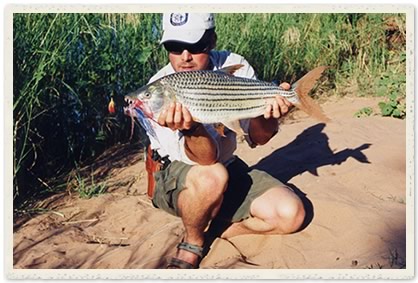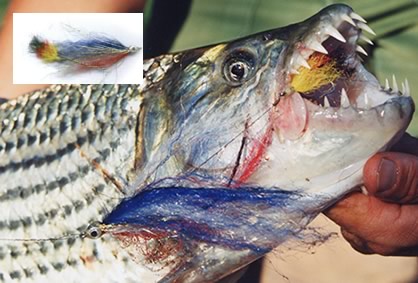Jozini Dam
June 17, 2006

Situated in the North Eastern corner of KwaZulu Natal is the Pongolapoort dam, also know as the Jozini Dam. The surrounding shores with their abundant game and bird species and the lake itself providing excellent tiger fishing, the feel is that very reminiscent of Lake Kariba in Zimbabwe.
Historically, this land North of the Pongola River used to be part of Swaziland. It was handed over to the Zuid Afrikaanse Republic in the 1800′s to form a buffer zone between the Zulu tribe and the Swazis who were experiencing attacks on their family and cattle from the Zulus. As no one wanted to live between these tribes, and due to many species of animals dying off from prolific hunting, Paul Kruger proclaimed this area a Game Reserve, the first ever to be proclaimed in Africa in 1894. The Pongola Game Reserve.
The dam was originally built in 1970 as part of an irrigation scheme providing the Makatini flats with water. However this project never came to fruition. The first time the level of water was ever higher than 12% was in 1983 when the cyclone Demoina floods filled it in 3 days! This massive expanse of water (16000ha) is the third largest dam in South Africa. All the fish which inhabited the Pongola River now thrive in the lake, both endemic yellow fish, barbel, tilapia and tigerfish as well as exotics such as black bass and carp. The most exciting prospect is the thought of being able to pursue the reputable tigerfish within the borders of South Africa, as the lake is about it’s Southern most distribution.. In the early years the lake was very discoloured after being filled by the silt laden flood waters of Demoina, and it took a long time for the waters to settle. Tiger fish being a sight orientated super predator obviously operate better in clearer water and hence the fishing on Jozini in the early days was very mediocre. The past two seasons have seen much lower than average annual rainfall, a great shame for the surrounding bush and its occupants but good news for the fisherman. Most areas of the lake have wonderfully clear water making for exceptional fishing. Conventional ways of catching tigers in Jozini include livebait, fillet, and trolling with lures. however the low levels of the lake and the improved clarity have meant improved success for the fly-fisherman. A boat is essential when fishing the lake as the shores are littered with previously submerged trees resulting in a very Kariba like setting, also there are crocodiles and hippo present, not ideal for wading! A stable boat with a depth finder allows one to locate old river beds, drop offs and other structure which the predatory tigers will use to ambush their prey. Drifting along weed beds and this structure, flies can be cast towards them and then retrieved simulating baitfish breaking cover and making themselves easy prey.
Although the tiger fish on Jozini can be caught all year round they are most active in the warmer months, if seasonal rain does not discolour the lake, especially the productive river mouth the whole summer fishes very well. Otherwise September, October and then March and April when the water clears again after the rains.

A reputation for unadulterated aggression and power precedes this fish and tackle must be geared accordingly. A standard saltwater 8/9 weight outfit with a selection of floating, intermediate and fast sinking shooting heads and at least a 12lb tippet is what is required if catch and release is to be seriously considered. A reliable reel with a smooth yet unforgiving drag will be necessary if a larger fish is hooked and kites out into the swift current. 100m of backing and a reel of the large arbor variety with good pick up, makes situations more controllable if the swift fork tailed steam train turns up current and heads back towards you. Lighter rods can be used especially for smaller fish but these sticks will never generate the power needed to set the hook when a sizable fish takes. A steel trace goes without mentioning, but a difficult balance in length must be struck between being long enough so as to avoid “bite off” but short enough so as not to hinder the fly’s swimming action. A good selection of sparsely tied Bucktail and copper bodied streamers should be on hand. Although the most attractive looking material in the water bucktail takes a lot of abuse from the tigers teeth and very soon can look quite disheveled, modern synthetics do however last a lot better. Flies tied to swim upside down definitely seem to have a better hook up rate and as ever if only restricted to one fly for predatory fish one will never go wrong with a chartreuse and white Clousers minnow. There is no doubt that the largest tigers are the highly predatory females and they love nothing than chomping smaller tigers. An excellent pattern – The Baby Tiger is tied with a stinger hook, stainless steel chemically sharpened, goes with out mentioning. The colours of this fly match a young tiger to the tee, with a graded black, blue and then white body, black barring, red orange and black tail and fin markings, big eyes and a red gill flash. I carry this fly in 3, 6, and 8 inch version, the latter is like trying to cast a wheelbarrow, but fished over the drop offs this can produce some trophy fish. Due to the length of some of these flies a stinger hook is imperative otherwise the fish will merely take short. A smaller trailing stinger does definitely improve the rate of landed fish as it should be inverted and consequently hooks into the roof of the palate, a slightly softer part of the typically bony mouthparts. High-density foam, home made or pre-molded popper heads will allow the angler to immediately target surface feeding fish. Keeping the tail of the fly short and the hook barbless and the point needle sharp will result in more strikes, improved penetration and a better hook up rate. So gear up and prepare to do battle with the arguably, the worlds best freshwater gamefish, without having to travel to the far flung corners of Africa.
Numerous spectacular lodges and house boat operations offer excellent accommodation, cruises, game drives and of course fishing in this unique environment. Drifting in a boat with the backdrop of the Lebombo mountains, casting for tigerfish while rhino look on is exactly as impressive as it sounds.
GETTING THERE:
International visitors fly into Johannesburg International Airport. Dullstroom is 40km from the airport and provides an ideal base for fishing and safaris in the Jozini Dam area.
FACILITIES:
You have the choice of luxury lodge accommodation, house boats, or simple village based bed and breakfasts. In addition to fishing, there are photographic and safari adventure opportunities.
COSTS:
Prices for all inclusive accommodation range from R250-1200/night based on two sharing. All in guided fishing costs from R1900-2500/day. Week packages by arrangement.
Contact:
Telephone: +27 1325 40270
Website: The Mavungana Flyfishing Centre